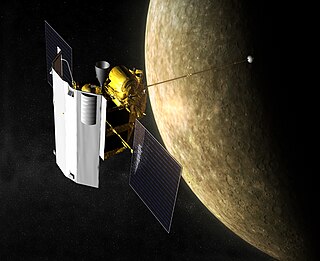
MESSENGER was a NASA robotic space probe that orbited the planet Mercury between 2011 and 2015, studying Mercury's chemical composition, geology, and magnetic field. The name is a backronym for Mercury Surface, Space Environment, Geochemistry, and Ranging, and a reference to the messenger god Mercury from Roman mythology.
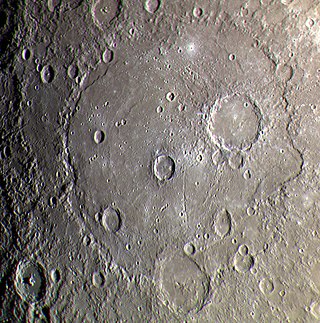
Beethoven is a crater at latitude 20°S, longitude 124°W on Mercury. It is 630 km in diameter and was named after Ludwig van Beethoven. It is the eleventh largest named impact crater in the Solar System and the third largest on Mercury.

Mozart is a crater on Mercury, named by the IAU in 1976 after Austrian composer Wolfgang Amadeus Mozart.
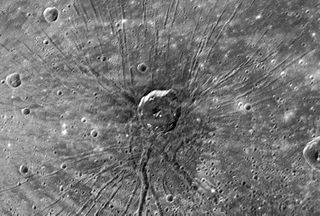
Apollodorus is an impact crater on Mercury. Its unusual appearance, with radiating dark troughs, led to a nickname of "the Spider" by scientists before its official name was decided. Apollodorus is located near the center of Pantheon Fossae, which is a system of radial grabens situated in the inner part of the Caloris basin. The floor, rim and walls of Apollodorus expose a low reflectance material (LRM) excavated during the impact from beneath the light volcanic plains, which cover the central part of the Caloris.

Praxiteles is a crater on Mercury. It is one of 110 peak ring basins on Mercury.

Moody is an impact crater on Mercury.

Navoi is a crater on Mercury. It contains uncommon reddish material that indicates a different rock composition from its surroundings. Navoi also appears to have an irregularly shaped depression in its center. Such depressions have been seen elsewhere on Mercury, including within Praxiteles crater, and may indicate past volcanic activity.

Raditladi is a large impact crater on Mercury with a diameter of 263 km. Inside its peak ring there is a system of concentric extensional troughs (graben), which are rare surface features on Mercury. The floor of Raditladi is partially covered by relatively light smooth plains, which are thought to be a product of the effusive volcanism. The troughs may also have resulted from volcanic processes under the floor of Raditladi. The basin is relatively young, probably younger than one billion years, with only a few small impact craters on its floor and with well-preserved basin walls and peak-ring structure. It is one of 110 peak ring basins on Mercury.

Gibran is a crater on Mercury and is in the east of the Shakespeare quadrangle. It was named after Lebanese-American poet Khalil Gibran in 2009. Gibran is located east of the rayed crater of Degas and nearby Damer.

Glinka is a pit-floored crater on Mercury, which was discovered in 1974 by Mariner 10 spacecraft. It was named by the IAU in 2008, after Russian composer Mikhail Glinka.

Scarlatti is a pit-floored crater on Mercury, which was discovered in 1974 by the Mariner 10 spacecraft. It has a prominent peak ring, and it is one of 110 peak ring basins on Mercury. The crater floor is covered by the smooth plains material. The crater displays an arcuate collapse feature along the northeastern peak ring. The size of the pit, which was first noticed in MESSENGER images obtained in January 2008, is 38 × 12 km. Such a feature may have resulted from collapse of a magma chamber underlying the central peak ring complex of the crater. The collapse feature is an analog of Earth's volcanic calderas. Scarlatti is thought to have the same age as the Caloris basin.

To Ngoc Van is a pit-floored crater on Mercury, named after the Vietnamese artist Tô Ngọc Vân. It was discovered in January 2008 during the first flyby of the planet by MESSENGER spacecraft. Its floor displays an irregularly shaped collapse feature, which is called a central pit. The size of the pit is 21 × 10 km. Such a feature may have resulted from collapse of a magma chamber underlying the central part of the crater. The collapse feature is an analog of Earth's volcanic calderas.
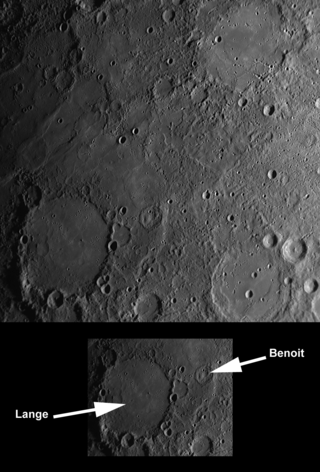
Lange is a crater on Mercury. It was named by the IAU in 2009 after American photographer Dorothea Lange.

Dominici is a crater on Mercury. It was named by the IAU in 2010.

Picasso is a crater on Mercury. It has drawn scientific attention because of the large, arc-shaped pit crater located on the eastern side of its floor. Similar pits have been discovered on the floors of several other Mercury craters, such as Beckett, Glinka, and Gibran. These pits are postulated to have formed when subsurface magma subsided or drained, causing the surface to collapse into the resulting void. If this interpretation is correct, pit-floor craters such as Picasso provide evidence of shallow magmatic activity in Mercury's history.

Geddes is a crater on Mercury. It has a diameter of 84 kilometers. Its name was adopted by the International Astronomical Union (IAU) in 2010. Geddes is named for the Irish stained glass artist Wilhelmina Geddes, who lived from 1887 to 1955.
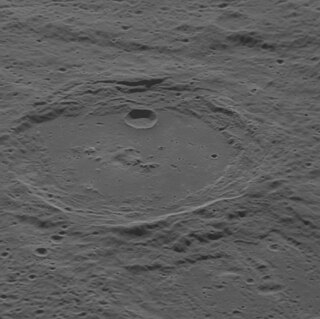
Hauptmann is a crater on Mercury. It has a diameter of 118 kilometers. Its name was adopted by the International Astronomical Union (IAU) in 1985. Hauptmann is named for the German playwright Gerhart Hauptmann, who lived from 1862 to 1946.

Enheduanna is a crater on Mercury. It has a diameter of 105 kilometers. Its name was suggested by Gagan Toor from India in a naming contest which was eventually adopted by the International Astronomical Union (IAU) on 2015. Enheduanna is named for the Sumerian poet Enheduanna. The craters Carolan, Kulthum, Karsh, and Rivera were also named as part of the contest.

Pahinui is a crater on Mercury. Its name was adopted by the International Astronomical Union in 2016, after the Hawaiian musician, Charles Phillip Kahahawai "Gabby" Pahinui.

Grainger is a crater on Mercury. Its name was adopted by the International Astronomical Union (IAU) in 2012, after the Australian-born composer George Percy Aldridge Grainger.





















